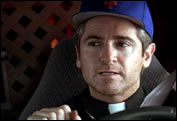The other day I was watching an interview program on TV, and the discussion went something like this:
INTERVIEWER: Do you feel ashamed of what your political party did the other day?
GUEST: I think that what they were really trying to do was signal their concern about this urgent problem.
INTERVIEWER: You didn’t answer my question: Do you feel ashamed of what your party did?
GUEST: I’ll tell you who should feel ashamed of what they’ve done. It’s the other party!
INTERVIEWER: Again, you didn’t answer my question: Do you feel ashamed of what your party did?
GUEST: I’m telling you that the other party need to be thoroughly ashamed of its actions!
At this point, the interviewer gave up and moved on to a new question. I must admit that what he had done thus far was pretty gutsy. He was asking a very pointed, “hardball” question of the guest, and stuck it to him three times. But ultimately, he folded and let the guest have his way in dodging the question.
So I want to give the interviewer credit for that. But by the third non-answer I was so frustrated with the guest that what I wanted the interviewer to say was: “Okay, you’re out of here. Persistent refusal to answer the question.”
That’s at the core of a TV show I would like to see on the air. I know, Bill O’Reilly has his “No Spin Zone,” in which he will reject answers that aren’t directed to the questions he’s asked, but he doesn’t eject guests who persistently refuse to cough up some kind of answer.
That’s what I’d like to see.
I’m so sick of watching political hacks (from *both* parties, though one seems to be worse than the other these days) dodge questions and refuse to give serious answers. This is something I feel particularly strongly about as someone who is called upon to give serious answers to people’s questions every week. Even when the answer is uncomfortable to give, I want to give it as a matter of principle.
But the political hacks who appear on TV these days don’t. In fact, for them doding questions is a studied art form. The better at it they are, the more they are admired in hack circles. But as Scripture says, what is praiseworthy in the eyes of men is abominable in the eyes of God. What they ware doing is a form of dehumanizing manipulation that treats the viewer as an animal to be tricked rather than a person to be persuaded. It does not elevate the discussion and deserves thoroughgoing condemnation.
Thus the idea for my show: People come on. The interviewer asks them a question, and they get three chances to give a straight answer. If they do give a straight answer (and, “I don’t know” is a straight answer) then they get a new question, up to the length of the interview segment. But if they don’t give one then the interviewer declares “You’re out of here. Persistent refusal to answer the question,” and the host brings in a new guest.
Of course, you’d need items lined up to fill the rest of the show in case of guest ejection, but I suspect there would need to be fewer filler-interviews (including pre-taped segements kept in reserve and rotated through so they stay fresh) than you might expect. If the rules are consistently enforced then guests will not make the mistake of refusing to answer. Those guests who are not prepaired to give straight answers will not come on the show, meaning that the show will have almost all quality guests who will raise rather than lower the standard of discussion and will treat the audience like people to be reasoned with instead of animals to be herded.

